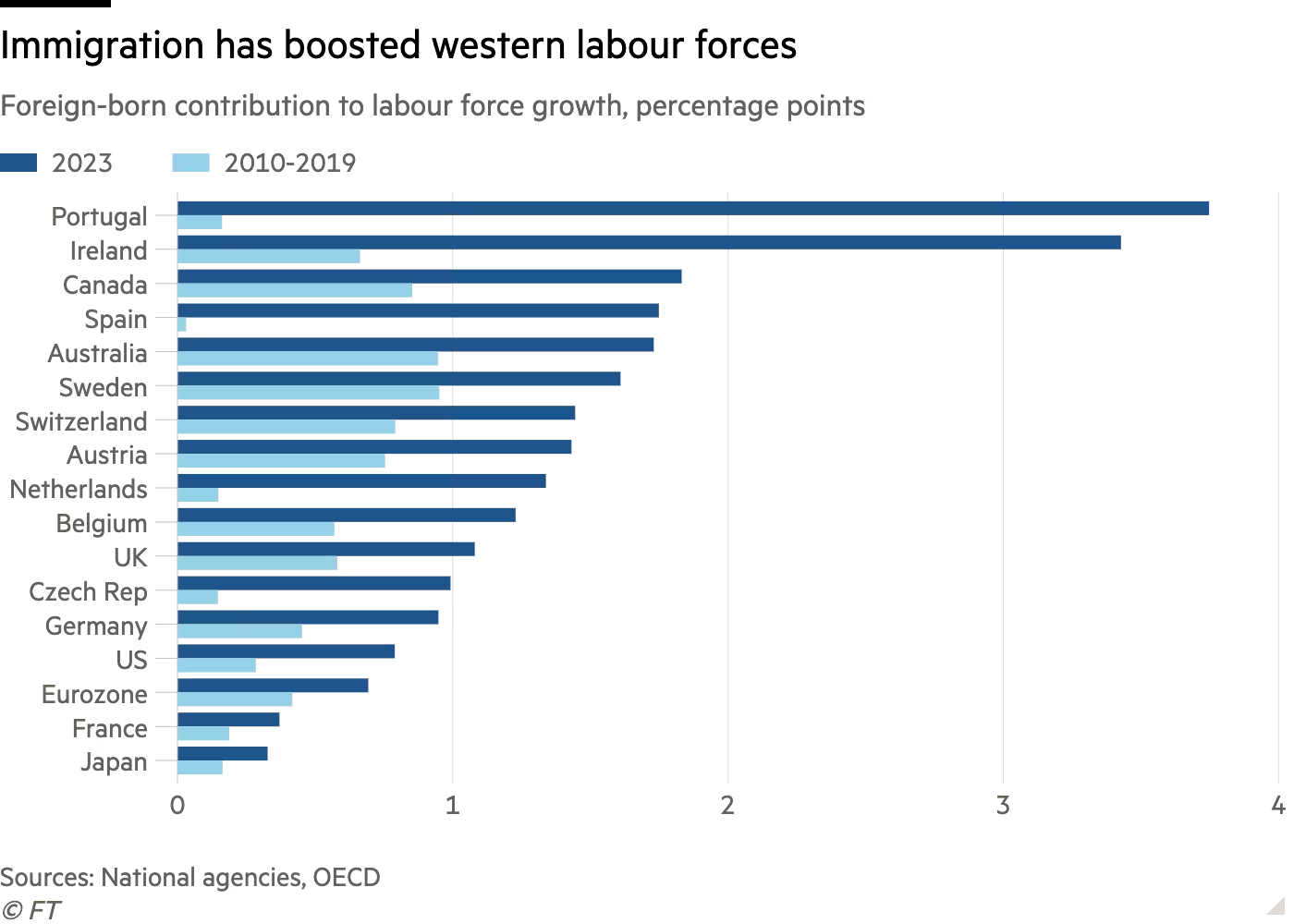From US to Europe & much more
Bans don't work for Huawei, while immigration helps developed economies. Germany struggles with her demography & India produces her first microcontroller chip. Finally, one chart implies many things.
Huawei still supporting US research despite all bans in place
A recent report from Bloomberg unveils Huawei Technologies Co.'s covert support of advanced research endeavors at prominent American universities, including Harvard, through an independent foundation based in Washington.
The telecommunications giant, blacklisted by the United States, serves as the exclusive sponsor of a research competition initiated in 2022, channeling substantial funding and garnering significant attention from global scientists, despite restrictions imposed by leading US academic institutions on collaborations with Huawei.
Documents and sources familiar with the situation reveal that the competition, managed by the Optica Foundation—an entity affiliated with the nonprofit professional society Optica—has attracted considerable interest and financial backing from Huawei.
Notably, the foundation's decision to accept Huawei's contribution underwent rigorous scrutiny by external legal advisors and received formal endorsement from its governing board.
This discreet philanthropic endeavor contrasts with Huawei's public engagement in various European nations.
The research outcomes stemming from this initiative are anticipated to possess strategic significance for both defense and commercial applications.
Noteworthy research areas highlighted by the Optica Foundation, as indicated in its online communication, include the exploration of "undersea and space-based solutions for the global communications grid" and the development of "high-sensitivity optical sensors and detectors."
OECD says immigration helps boost developed economies
Substantial immigration influxes into affluent nations are contributing to the reinforcement of job markets and the enhancement of economic growth.
Notably high migration flows recorded in OECD countries such as the US, UK, Canada, Spain, and Australia in the previous year have alleviated the constraints on labor markets and amplified gross domestic product.
The robust presence of the labor force has been integral to the growth trajectory observed in the US, with significant migration rates undeniably contributing to this phenomenon.
The impact of migration on the trajectory of wage growth remains uncertain, warranting further examination.
While some economists attribute the surge in US immigration as a pivotal factor behind the unexpectedly robust job growth witnessed in recent months, this perspective is countered by others.
Germany’s aging population
Germany's demographic challenge, characterized by its aging population, was starkly emphasized by a notable 7.6 percent decline in the number of marriages within the nation.
This decline marked the lowest level recorded since data collection commenced in 1950.
Reforms enacted by the government in 2005 and 2007 aimed at enhancing childcare services and bolstering financial support for individuals on parental leave have contributed to an uptick in the proportion of women participating in the workforce.
However, recent years have seen a regression in these advancements.
Labor shortages have compelled daycare facilities to reduce their operating hours.
Additionally, fiscal constraints imposed by governmental budgetary pressures have constrained parental leave entitlements for high-income earners and diminished funding allocated for the expansion of childcare services.
Addressing the imperative of averting a decline in the labor force, the employment agency has sounded the alarm, advocating for the attraction of 400,000 immigrants annually.
Responding to this call, the government introduced novel visa programs tailored to entice skilled professionals in the preceding year.
Indian startup developing its microcontroller chip for the first time
An Indian startup has achieved a significant milestone by developing the nation's inaugural domestically produced microcontroller semiconductor.
This breakthrough holds promise for providing a more cost-effective alternative to manufacturers of consumer electronics and bolstering digital infrastructure across India.
Mindgrove Technologies, supported by Peak XV Partners and incubated by the IIT Madras Pravartak Technologies Foundation and IIT Madras Incubation Cell, recently unveiled India’s premier commercial high-performance System on Chip (SoC) known as Secure IoT.
Distinguished by its affordability, the chip boasts a 30 percent reduction in cost compared to existing market offerings.
Its versatility enables integration into a diverse array of devices, spanning from smartwatches to various smart city applications such as connected utility meters for electricity, water, and gas.
Moreover, it finds utility in household appliances like fans and speakers, as well as in the battery management and control systems of electric vehicles.
With a clock speed of 700 MHz, this high-performance microchip controller stands out as the sole commercially available chip of its kind originating from India.
Do you notice a deep divide between the erstwhile Soviet Union states and others when you see the chart depicting GDP per capita 2024 for Europe?
The noticeable divergence between the former Soviet Union states and other regions is readily apparent upon observing the map. It’s self-explanatory otherwise.






